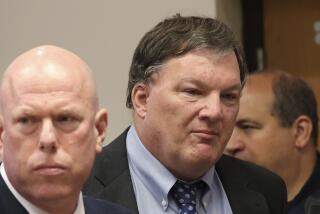Palm Print Found at Scene of Southside Serial Killing
- Share via
A palm print apparently belonging to the so-called Southside Serial Slayer has been found at the scene of one of the 18 killings, a knowledgeable law enforcement source said Thursday, but there is a question of how valuable that evidence may be.
Unlike fingerprints, palm prints are not included in the state Department of Justice’s computerized print identification system, the source said. And the Los Angeles Police Department’s automatic fingerprint identification system, scheduled to go into service next January, also will not have the ability to process palm prints.
Police Lt. John L. Zorn, co-leader of the Southside Serial Killer Task Force, could not be reached for comment on the matter.
Word of possible prints surfaced earlier this week when the City Council authorized $10,000 in overtime pay for civilian experts in the Police Department’s scientific investigation department. A council resolution said the money was needed to “compare fingerprints of suspects against latent prints obtained from Southside Slayer cases.”
Meantime, at a news conference Thursday, Los Angeles County Supervisor Kenneth Hahn called for an all-out, unified community effort to bring the Southside killer to justice. Twenty-four clergymen, politicians, police officers and community leaders attended the conference and joined in a pledge to work together to end what Hahn called “this reign of terror.”
However, the news conference was not without some harsh words aimed at detectives investigating the slayings, most of which have involved prostitutes.
City Councilman Robert Farrell said, “I simply don’t believe that the best and the brightest” detectives have been assigned to the investigation.
He did not amplify on that statement during the conference, but in a news release handed out to reporters he did say:
“There is an increasing perception among community groups in South Los Angeles and adjacent Los Angeles County areas that there is a lack of full commitment of city and county resources. We must take all actions available to us to alleviate these concerns and fears.” Many of the murders, which began in 1983, have occurred in Farrell’s district.
Police Capt. Jerry Bova, commanding officer of the robbery-homicide division, who attended the conference, said in reference to Farrell’s remarks that “I do not agree with that. The best homicide detectives are assigned (to the cases) and they are very, very committed. . . .”
He also said he did not believe that the police and the Sheriff’s Department needed help from the FBI, as Hahn had proposed. “I can’t think of anything that the FBI can do that we are not already doing,” Bova said. But he added that the Police Department would cooperate with the FBI or any other organizations in the investigation.
Hahn, in requesting that the FBI join in the investigation, told the conference: “We need all the help we can get.”
In fact, FBI spokesman Jim Neilson said, the agency had previously been asked by the task force for technical assistance from the bureau’s identification division and its behavioral science unit at Quantico, Va.
Capt. Bob Grimm of the Sheriff’s Homicide Bureau also defended the task force. He said many of the 50 police and sheriff’s detectives assigned to the task force are working 12 to 16 hours a day. He echoed Bova in saying that people in the community “know who he (the killer) is . . . or know things he is doing” that would be helpful in solving the brutal slayings.
Although the slayings were attributed by speakers at the conference to a single killer, Bova said he shares Sheriff Sherman Block’s “gut feeling” that there is more than one murderer responsible for the crimes. He did not elaborate.
Hahn again noted that $35,000 in rewards--$25,000 from the city, $10,000 from the county--are being offered for information leading to the arrest and conviction of the killer or killers.
Councilman Farrell said he would seek to increase the city’s reward offer.
Several of the clergymen at the conference said they would raise reward money and help distribute 10,000 posters and 25,000 leaflets depicting a composite drawing of a man sought in the slayings.
More to Read
Sign up for Essential California
The most important California stories and recommendations in your inbox every morning.
You may occasionally receive promotional content from the Los Angeles Times.













